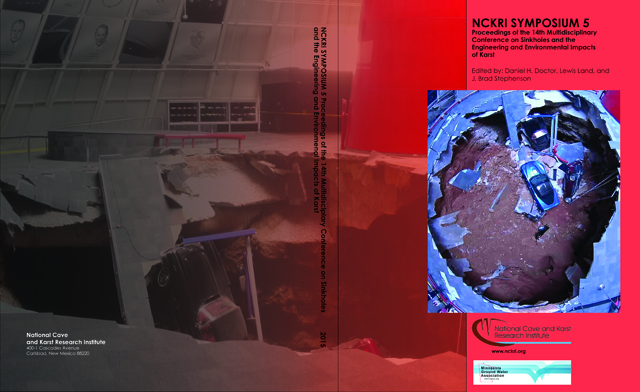Abstract
A sinkhole measuring 40 m in diameter and up to 6.5 m deep occurs within the Nachusa Grasslands, near the town of Franklin Grove, northwestern Illinois. This area, dedicated to prairie conservation and restoration, is owned and operated by The Nature Conservancy. Several meters of unconsolidated sand, gravel, and clay overlie the St. Peter sandstone, beneath which lies karstic Prairie du Chien dolomite. Investigations included EM conductivity profiles, resistivity soundings, 2D resistivity, and ground- penetrating radar (GPR), supplemented by conductivity logs, soil cores, and tree core studies. These data indicate the sandstone averages about 5 m deep near the sinkhole rim and the sinkhole is about 120 years old. Nearby residential wells indicate an average static water level of 11 m below the surface, so the water table currently lies well below the sinkhole floor. GPR sections show abrupt termination of the bedrock reflector near the sinkhole rim, suggesting formation by collapse. Geophysical investigations also identified possible hydraulic conduits associated with the sinkhole. Specifically, GPR profiles, at 50 and 100 MHz, provide the highest resolution images of the subsurface and indicate possible conduits (soil pipes) near the sinkhole rim as diffraction hyperbolas 2-3 m below the surface. GeoProbeTM conductivity logs showing unusually low conductivity, and sudden probe drops, also suggest the presence of shallow soil cavities around the sinkhole. However, dye poured into various low spots on the sinkhole floor was never recovered, despite numerous sampling locations.
DOI
http://dx.doi.org/10.5038/9780991000951.1078
Investigation of a Sinkhole in Ogle County, Northwestern Illinois, Using Near-Surface Geophysical Techniques
A sinkhole measuring 40 m in diameter and up to 6.5 m deep occurs within the Nachusa Grasslands, near the town of Franklin Grove, northwestern Illinois. This area, dedicated to prairie conservation and restoration, is owned and operated by The Nature Conservancy. Several meters of unconsolidated sand, gravel, and clay overlie the St. Peter sandstone, beneath which lies karstic Prairie du Chien dolomite. Investigations included EM conductivity profiles, resistivity soundings, 2D resistivity, and ground- penetrating radar (GPR), supplemented by conductivity logs, soil cores, and tree core studies. These data indicate the sandstone averages about 5 m deep near the sinkhole rim and the sinkhole is about 120 years old. Nearby residential wells indicate an average static water level of 11 m below the surface, so the water table currently lies well below the sinkhole floor. GPR sections show abrupt termination of the bedrock reflector near the sinkhole rim, suggesting formation by collapse. Geophysical investigations also identified possible hydraulic conduits associated with the sinkhole. Specifically, GPR profiles, at 50 and 100 MHz, provide the highest resolution images of the subsurface and indicate possible conduits (soil pipes) near the sinkhole rim as diffraction hyperbolas 2-3 m below the surface. GeoProbeTM conductivity logs showing unusually low conductivity, and sudden probe drops, also suggest the presence of shallow soil cavities around the sinkhole. However, dye poured into various low spots on the sinkhole floor was never recovered, despite numerous sampling locations.

